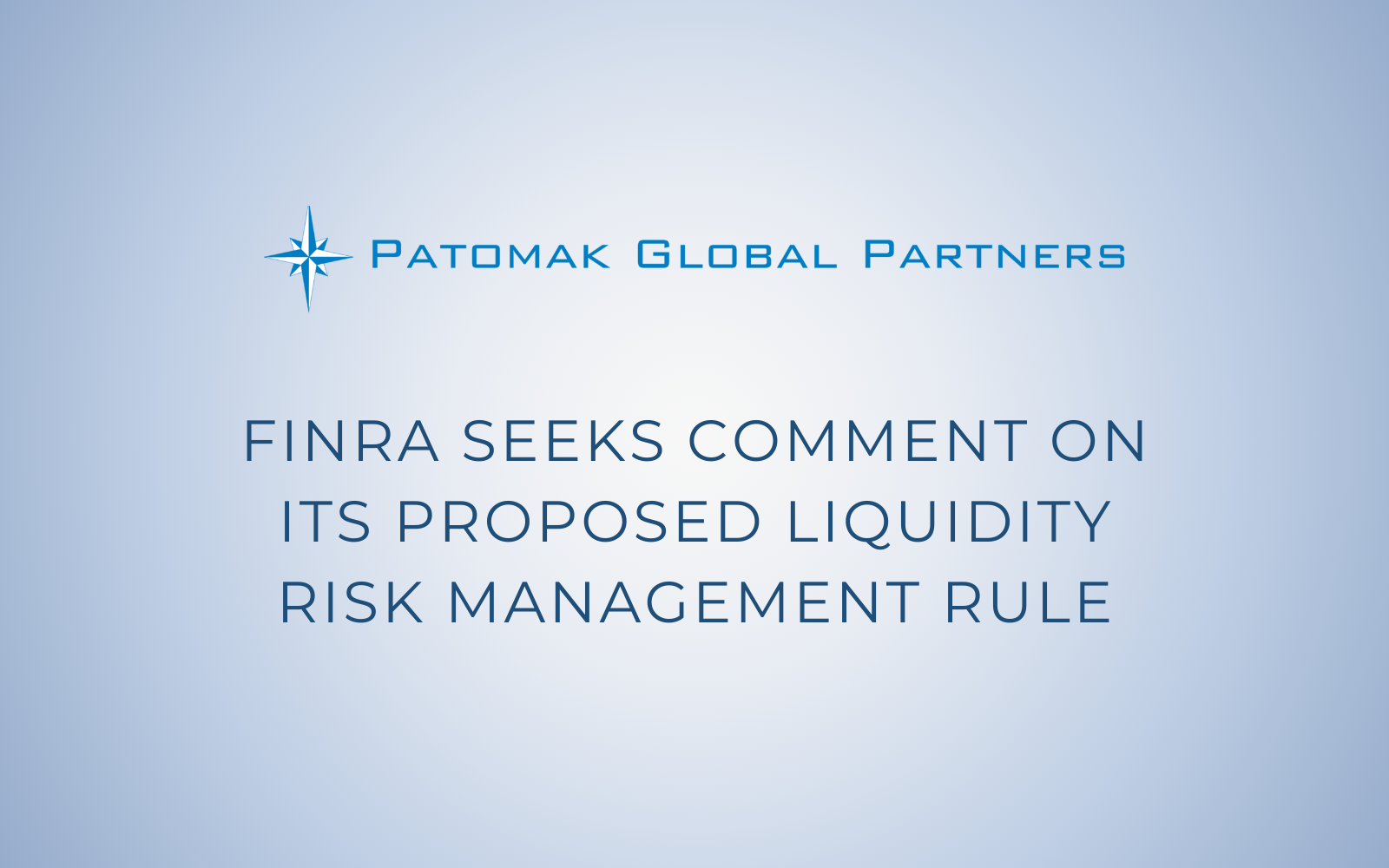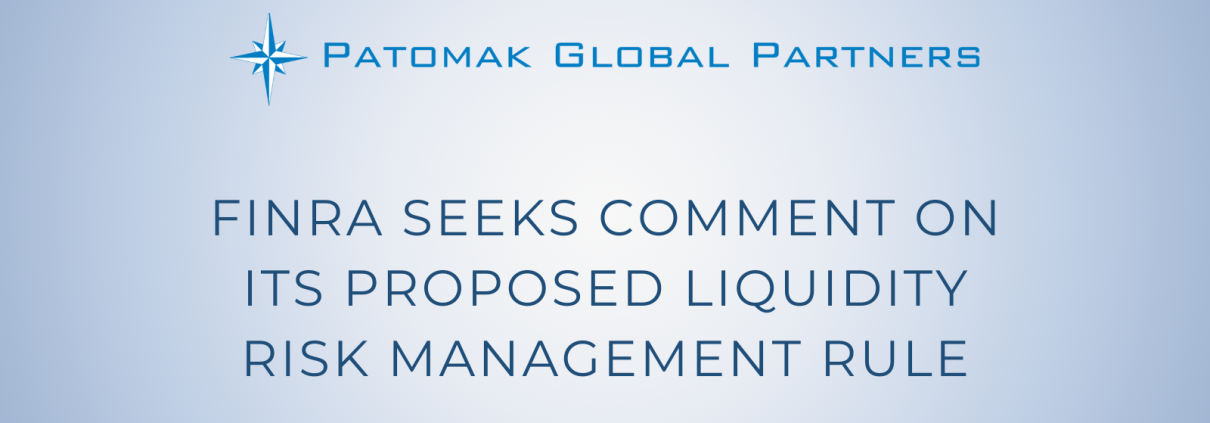FINRA Seeks Comment on its Proposed Liquidity Risk Management Rule
On June 12, 2023, the Financial Industry Regulatory Authority (FINRA) announced that it is seeking comments on a concept proposal for a Liquidity Risk Management rule (Proposed Rule 4610, or Proposal) as a measure purported to ensure that required broker-dealers maintain adequate liquid assets to fulfill their funding requirements under both normal and stressed conditions. Comments are due by August 11, 2023.
The Proposal contains four primary pillars with which in-scope registrants would need to comply:
- Establish a Liquidity Risk Management Program, ensuring a systemic approach to managing liquidity risk.
- Conduct comprehensive liquidity stress testing to assess the ability of the firm to withstand liquidity shocks.
- Establish contingent funding plans to ensure access to necessary funds when faced with unexpected liquidity challenges.
- Maintain a sufficient level of liquidity on a current basis at all times.
Patomak Insight
The Proposal’s pillars (requiring a formal Liquidity Risk Management Program, comprehensive liquidity stress testing, contingent funding plans, and maintenance of minimum liquidity levels) are concepts that have been required through regulation or formal guidance at commercial banks for many years. The Proposal would complement the existing SEC Net Capital Rule, which focuses on ensuring broker-dealers possess minimum capital and adequate liquid assets to promptly fulfill obligations to customers and creditors. The difference is that the Net Capital Rule primarily addresses the asset side of broker-dealers’ balance sheets and customer protection, while the Proposal would focus on the liability side of the balance sheet and implementing a comprehensive liquidity risk management framework.
Failure to maintain sufficient liquidity puts customers’ assets at risk and subjects members to market/counterparty acceptance, serious operational and capital challenges, and regulatory penalties, which substantially increase reputation risk and overall compliance risk. The Proposal would require a more forward-looking and stressed view of a firm’s liquidity risk profile, with a greater emphasis on funding events. The Proposal outlines specific point-in-time adverse event triggers as opposed to bank liquidity rules that look to future coverage (e.g., Liquidity Coverage Ratio and Net Stable Funding Ratio rules). However, some of the approaches used in bank forecasting and stress processes would apply to the contingent funding plan and stress testing components of the FINRA rule.
Under the Proposal, affected members would be required to have and maintain cash and liquid assets sufficient to meet their funding obligations as they come due. The Proposal delineates eight specific events of which an in-scope member needs to be aware to avoid materially adverse regulatory outcomes, including the use of non-bank affiliate funding, instances of lost funding (lines of credit, securities financing, intraday credit from a settlement bank), and some corporate events (e.g., withdrawal requests from Special Reserve Bank Account and lost or restricted access to settlement banks and central clearing counterparties). Each of the eight conditions has specific metrics and rebuttal factors that FINRA will consider in determining whether a broker-dealer is maintaining sufficient liquidity on a current basis.
FINRA may conclude that a member subject to the potential rule does not have sufficient liquidity if a member does not submit a rebuttal with supporting evidence, if it determines that the rebuttals do not meet specific criteria, or for any other reason. As a result, FINRA could direct the member to take such measures as reasonably necessary to restore the sufficiency of the member’s liquidity, including restricting or suspending all or part of a firm’s business. Clearly, a firm’s risk governance practices should incorporate a framework for monitoring metrics levels and trends to ensure that corrective strategies can be implemented prior to the occurrence of a liquidity-stress event.
Although FINRA has suggested various anticipated benefits from implementing the Proposal, including consistent minimum liquidity risk management standards and increasing firm and market resiliency, there undoubtedly will be associated costs that will arise with compliance, including financing, operating, and compliance costs. Patomak also anticipates that members may incur data harvesting and data governance costs, Management Information Systems (MIS) development and MIS governance costs, and additional audit costs.
Put Patomak’s Expertise to Work
Patomak has deep experience designing and assessing liquidity risk management programs at broker-dealers, investment advisers, banks, swap dealers, digital asset trading platforms, and other financial firms. Our work has included assessing and identifying opportunities for enhancements to internal risk management, governance, reporting frameworks, control functions, and MIS. Additionally, Patomak has worked with risk managers to develop and apply certain assumptions for meeting the requirements of contingency funding and stress reports and has reviewed firm capital levels for adequacy with regulatory requirements. Further, Patomak has deep experience in helping financial institutions draft and submit comment letters to the SEC, CFTC, and FINRA related to rule proposals.
If you would like to learn more about how Patomak can partner with you, please reach out to Paul Atkins, CEO at patkins@patomak.com, Laura Magyar, Managing Director, at lmagyar@patomak.com, or John Vivian, Senior Director, at jvivian@patomak.com.





